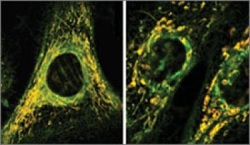 |
| A healthy cell (left) and one with oxidative damage from antibiotics (right).--Courtesy of Harvard |
Researchers at Harvard University have discovered why long-term treatment with some antibiotics can lead to harmful side effects and have developed two combination delivery strategies that could help mitigate the problem.
The scientists at Harvard's Wyss Institute for Biologically Inspired Engineering published results in the journal Science Translational Medicine that show the damage that clinical levels of antibiotics can cause to DNA, proteins and lipids. The drugs were found to be safe 6 hours after treatment but led to complications with mitochondrial malfunction due to oxidative stress after four days.
"Clinical levels of antibiotics can cause oxidative stress that can lead to damage to DNA, proteins and lipids in human cells, but this effect can be alleviated by antioxidants," said lead researcher Jim Collins.
Two methods proved useful. Using bacteriostatic antibiotics, which stop bacteria from multiplying but don't kill them, made the drugs less toxic over time. The other involved combined delivery, adding an FDA-approved antioxidant called N-acetylcysteine (NAC) currently used to treat cystic fibrosis in children, according to Harvard University. NAC curtails oxidative stress by cleaning up extra oxygen molecules released as a result of the antibiotic.
"(Collins) and his team are moving at lightning speed toward unlocking the medical mysteries that stand in the way of safe and effective antibiotic treatment," said Wyss Institute founding director Don Ingber. "Doctors have known for years that antibiotics occasionally cause serious side effects, and Jim's new findings offer not one but two exciting new strategies that could address this long-neglected public health problem."
The team plans for more animal studies before potentially bringing the treatments to the clinic. Because both substances are already FDA-approved, they expect a speedy process.
- here's the Harvard report
- get the research abstract